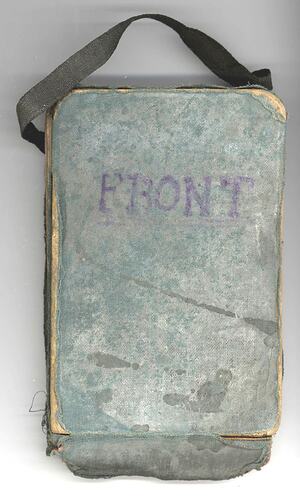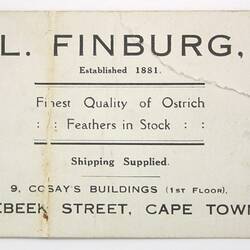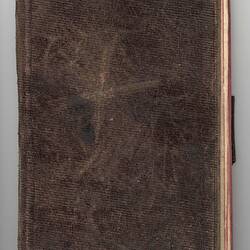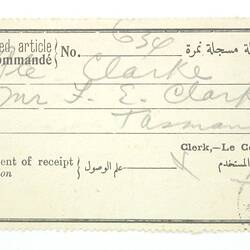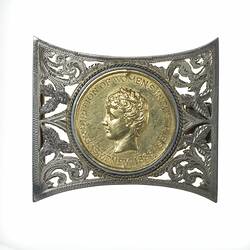Langley Edward Clarke (regimental number 1015) was a 22-year-old labourer from Pontville, Tasmania, when he enlisted to fight in World War I on 21 September 1914. He was assigned to the 15th Infantry Battalion, 4th Infantry Brigade, G Company. His military records in the National Archives record the supplies that were issued to him: a kahki felt hat, chin strap, three badges for his collar and hat, four badges 'Australia', jacket, greatcoat, brown ankle boots, leggings, universal kit bag, pair of braces, hair brush, shaving brush, tooth brush, 'comforter' cap, drawers, holdall, 'housewife', cardigan, two flannel shirts, three pairs of woollen socks and two towels. He was sent to Broadmeadows for training, and then embarked from Melbourne on the 'Ceramic' on 22 December 1914.
He became a gunner (at a later stage he was part of the 24th Howitzer Brigade), and arrived in Gallipoli on 9 July 1915. On 8 August he was wounded in the 'left side of the back', and four days later was admitted to the Australian General Hospital at Ghezireh, Egypt. Meanwhile, he was recorded as missing on 9 August, and not traced to the hospital until 21 August. He was further reported on 9 September as 'not seriously wounded'. A letter from his sister to Senator Pearce, Minister for Defence, on 3 September indicates that his family only found out about the wounding in The Sunday Times on 29 August, and were anxious for further information. By 19 September he was in Mena House convalescent hospital in Cairo, suffering from a 'back wound' but 'improving slowly'. (This hospital was administered by Australian Matron Ellen Julia Gould, earlier recipient of a medal held by Museum Victoria - NU 20556). By 10 December he was reported to be at the Australian base at Ghezireh - probably in the hospital there. His family believes he was wounded at the evacuation from Gallipoli on 20 December, although his service record in the National Archives does not mention him being sent back to the front or receiving another wound at this time. On 28 December he was transferred back to his unit.
In March 1916 Clarke was transferred to the 4th Australian Division Artillery. Sent to fight in France, he was promoted to the rank of bombardier in August 1916. In January 1917 he was transferred to the 10th FAB [Field Artillery Brigade], and subsequently was posted to the 38th Battalion. On 18 July 1917 he was gassed, and by 30 July he was admitted to the University War Hospital, Southampton, England, 'suffering the effects of shell gas - severe'. On 27 September he was shipped back to Australia, still suffering the effects of the gas including bronchitis. He was discharged from the Army on 29 January 1918.
Clarke worked on the Tasmanian Railways for some years after the war as a guard. A newspaper article from The Mercury, Tuesday 5 February 1929, page 11 mentions an Edward Langley Clarke, a porter for the Railway Department (Tasmania) who gave evidence at an inquest regarding the death of a man and the injuring of his father in a railway crossing collision.
In February, 1931, correspondence was sent between the Commonwealth Bank and the Records Offices of the A.I.F. as Edward Langley Clarke was applying for the position of messenger in the Bank's Perth offices, and as a reference check the bank was following up on his war records to see whether he had performed well while on military duty. The A.I.F was unable to find any records for a soldier of that name, and the bank then realised that the A.I.F records had reversed his given and middle names to Langley Edward, rather than Edward Langley. The A.I.F was eventually able to confirm that Clarke had performed exemplary service while in the military.
Sometime after his move to Western Australia Clarke became a self-employed livestock dealer. He took pride in being given 90 days credit on outstanding bills, instead of the usual 30, because it showed he was regarded as a trustworthy payer. Unfortunately he lost his business as a result of the Depression. At one stage he became an itinerant worker, moving around the country looking for work. Later he moved with his family to Melbourne, apparently on the way back to Tasmania, but the family ended up staying in Melbourne - probably in the suburb of Preston. Clarke worked as a bank messenger for the remainder of his working life. It was a position of trust as it included being witness when bank notes were cancelled. Preference was apparently given to returned servicemen in allocating these sorts of jobs.
Clarke served in the army again during World War II - in store and supply duties. Not long after the war, in 1948, his wife Vera Poppye Witzerman passed away, aged 52.
The wounds he suffered during World War I finally caught up with him: he was quite ill around the time he retired in the 1950s. He recovered after surgery for what was probably residual damage from the bullet wound which he received in Gallipoli. Part of his intestine had to be removed. His son once said that he was hit 'in the water', meaning a bullet struck him while he was about to board one of the small boats in the dark to leave the Gallipoli beach head. His grandson recalls being aware that he suffered some pain, 'because he lived with us for the last year of his life and I remember him talking about it just occasionally. He used to wear a neck brace when sleeping at times. He later served in France, was injured by gas and had to be evacuated to Australia before the war ended. I recall he had a bad cough and some difficulty talking because of a bronchial condition caused by exposure to gas.'
Clarke's grandson recalled 'we only saw Grandad intermittently because our family were living in England where my father was working until 1963. By the time we were seeing him regularly he was elderly...He talked only sparingly about war experiences, as you know veterans so often did. But when I asked him a few things he described a battle in which the Turks tried to drive the Australians out of their positions on the Gallipoli Peninsula and suffered appalling casualties. He also recalled a friend, who he called by name, being killed. I can't remember the friend's name.'
Clarke died in 1966, at the Greenslopes Repatriation General Hospital in Brisbane, and was cremated.
References:
Service records for Langley Clarke, National Archives of Australia - Series number B2455, Barcode 1969950
Pers.comm., Pamela Koehne-Drube with Andrew Clarke, grandson of Langley Edward Clarke, December 2011
The Mercury, Tuesday 5 February 1929, page 11 - http://nla.gov.au/nla.news-article24247039
More Information
-
Keywords
-
Localities
-
Authors
-
Article types
